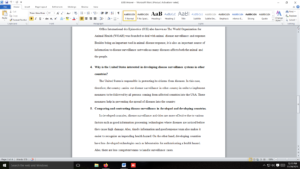Network of networks
1. Describe the WHO’s “network of networks” system of obtaining global surveillance data. What is Integrated Disease Surveillance and why using it?
2. How does the mission of the FAO relate to disease surveillance?
3. How is the work of the OIE related to disease surveillance?
5. comparing and contrasting disease surveillance in developed and developing countries.
THOROUGHLY ANSWER THE QUESTIONS
Answer preview
The United States is responsible in protecting its citizens from diseases. In this case, therefore, the country carries out disease surveillance in other country in order to implement measures to be followed by all persons coming from affected countries into the USA. These measures help in preventing the spread of diseases into the country.
- Comparing and contrasting disease surveillance in developed and developing countries.
In developed countries, disease surveillance activities are more effective due to various factors such as good information processing technologies where diseases are noticed before they cause high damage. Also, timely information and good response team also makes it easier to recognize an impending health hazard. On the other hand, developing countries have less developed technologies such as laboratories for authenticating a health hazard. Also, there are less competent teams to handle surveillance cases.
[578 Words]

Network of networks


